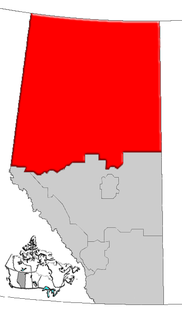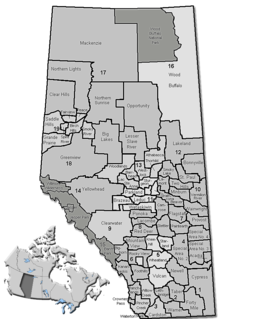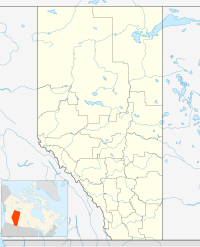
Beaver Lake is a hamlet in northern Alberta, Canada within Lac La Biche County. It is located on the shore of Beaver Lake, 4 kilometres (2.5 mi) east of Highway 55, approximately 116 kilometres (72 mi) northwest of Cold Lake.

Bellis is a hamlet in central Alberta, Canada within Smoky Lake County. Previously an incorporated municipality, Bellis dissolved from village status on January 1, 1946 to become part of the Municipal District of Vilna No. 575.

Edwand is a hamlet in central Alberta, Canada within Smoky Lake County. It is located 4 kilometres (2.5 mi) north of Highway 28, approximately 104 kilometres (65 mi) northeast of Edmonton.

Flat Lake is an unincorporated community in central Alberta in the Municipal District of Bonnyville No. 87, located 6 kilometres (3.7 mi) south of Highway 28, 74 kilometres (46 mi) southwest of Cold Lake.

Fork Lake is an unincorporated community in northern Alberta, Canada. It is located in Lac La Biche County, 6 kilometres (3.7 mi) south of Highway 55 and 93 kilometres (58 mi) west of Cold Lake.

Franchere is an unincorporated community in central Alberta in the Municipal District of Bonnyville No. 87, located 10 kilometres (6.2 mi) east of Highway 28A, 59 kilometres (37 mi) east of Cold Lake.

Hamlin is an unincorporated community in central Alberta in Smoky Lake County, located 15 kilometres (9.3 mi) south of Highway 28, 125 kilometres (78 mi) southwest of Cold Lake.

Hylo is a hamlet in northern Alberta, Canada within Lac La Biche County. It is located approximately 16 kilometres (9.9 mi) south of Highway 55 and 133 kilometres (83 mi) west of Cold Lake.

Imperial Mills is an unincorporated community in northern Alberta in Lac La Biche County, located 33 kilometres (21 mi) northeast of Highway 55, 117 kilometres (73 mi) northwest of Cold Lake.

Lottie Lake is a hamlet in northern Alberta, Canada within the County of St. Paul No. 19. It is located 1 kilometre (0.62 mi) west of Highway 36, approximately 138 kilometres (86 mi) northeast of Edmonton.

McRae is an unincorporated community in northern Alberta within the County of St. Paul No. 19, located 16 kilometres (9.9 mi) south of Highway 55, 99 kilometres (62 mi) west of Cold Lake.

Rich Lake is an unincorporated community in northern Alberta within Lac La Biche County, located 1 kilometre (0.62 mi) north of Highway 55, 93 kilometres (58 mi) west of Cold Lake.

Spedden is a hamlet in central Alberta, Canada within Smoky Lake County. It is located 0.3 kilometres (0.19 mi) north of Highway 36, approximately 106 kilometres (66 mi) southwest of Cold Lake. It was named after one of the original surveyors who died in the area in 1919. Previously it was Cache Lake.

St. Edouard is a hamlet in northern Alberta, Canada within the County of St. Paul No. 19. It is located 2 kilometres (1.2 mi) south of Highway 28, approximately 82 kilometres (51 mi) southwest of Cold Lake.

St. Lina or Ste-Lina in French, is a hamlet in northern Alberta, Canada within the County of St. Paul No. 19. It is home of St. Lina Community Hall. It is located approximately 14 kilometres (8.7 mi) north of Highway 28 and 85 kilometres (53 mi) southwest of Cold Lake.

St. Vincent is a hamlet in northern Alberta, Canada within the County of St. Paul No. 19. It is located 3 kilometres (1.9 mi) south of Highway 28, approximately 79 kilometres (49 mi) southwest of Cold Lake.

Therien is a hamlet in central Alberta, Canada within the Municipal District of Bonnyville No. 87, located approximately 7 kilometres (4.3 mi) north of Highway 28 and 74 kilometres (46 mi) southwest of Cold Lake.

Wardlow is a hamlet in southern Alberta, Canada within Special Area No. 2. It is located approximately 24 kilometres (15 mi) east of Highway 36 and 45 kilometres (28 mi) northeast of Brooks.

Lake Newell Resort is a hamlet in southern Alberta, Canada within the County of Newell that was established in 2007.

Goodfish Lake is an unincorporated community in northern Alberta within the Goodfish Reserve of the Whitefish Lake First Nation. It is located 12 kilometres (7.5 mi) east of Highway 36, 109 kilometres (68 mi) west of Cold Lake.






